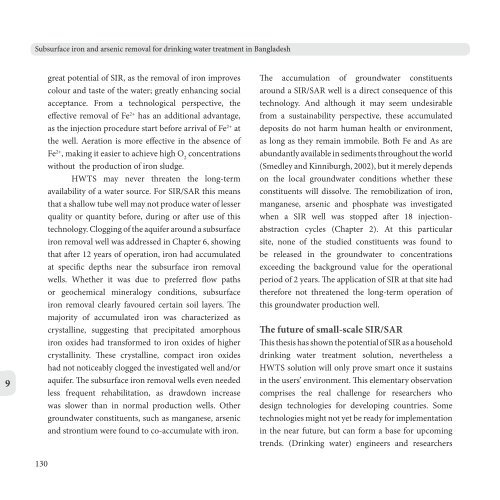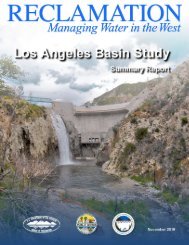Subsurface Iron and Arsenic Removal
qj78kp8
qj78kp8
- No tags were found...
You also want an ePaper? Increase the reach of your titles
YUMPU automatically turns print PDFs into web optimized ePapers that Google loves.
<strong>Subsurface</strong> iron <strong>and</strong> arsenic removal for drinking water treatment in Bangladesh<br />
9<br />
130<br />
great potential of SIR, as the removal of iron improves<br />
colour <strong>and</strong> taste of the water; greatly enhancing social<br />
acceptance. From a technological perspective, the<br />
effective removal of Fe 2+ has an additional advantage,<br />
as the injection procedure start before arrival of Fe 2+ at<br />
the well. Aeration is more effective in the absence of<br />
Fe 2+ , making it easier to achieve high O 2<br />
concentrations<br />
without the production of iron sludge.<br />
HWTS may never threaten the long-term<br />
availability of a water source. For SIR/SAR this means<br />
that a shallow tube well may not produce water of lesser<br />
quality or quantity before, during or after use of this<br />
technology. Clogging of the aquifer around a subsurface<br />
iron removal well was addressed in Chapter 6, showing<br />
that after 12 years of operation, iron had accumulated<br />
at specific depths near the subsurface iron removal<br />
wells. Whether it was due to preferred flow paths<br />
or geochemical mineralogy conditions, subsurface<br />
iron removal clearly favoured certain soil layers. The<br />
majority of accumulated iron was characterized as<br />
crystalline, suggesting that precipitated amorphous<br />
iron oxides had transformed to iron oxides of higher<br />
crystallinity. These crystalline, compact iron oxides<br />
had not noticeably clogged the investigated well <strong>and</strong>/or<br />
aquifer. The subsurface iron removal wells even needed<br />
less frequent rehabilitation, as drawdown increase<br />
was slower than in normal production wells. Other<br />
groundwater constituents, such as manganese, arsenic<br />
<strong>and</strong> strontium were found to co-accumulate with iron.<br />
The accumulation of groundwater constituents<br />
around a SIR/SAR well is a direct consequence of this<br />
technology. And although it may seem undesirable<br />
from a sustainability perspective, these accumulated<br />
deposits do not harm human health or environment,<br />
as long as they remain immobile. Both Fe <strong>and</strong> As are<br />
abundantly available in sediments throughout the world<br />
(Smedley <strong>and</strong> Kinniburgh, 2002), but it merely depends<br />
on the local groundwater conditions whether these<br />
constituents will dissolve. The remobilization of iron,<br />
manganese, arsenic <strong>and</strong> phosphate was investigated<br />
when a SIR well was stopped after 18 injectionabstraction<br />
cycles (Chapter 2). At this particular<br />
site, none of the studied constituents was found to<br />
be released in the groundwater to concentrations<br />
exceeding the background value for the operational<br />
period of 2 years. The application of SIR at that site had<br />
therefore not threatened the long-term operation of<br />
this groundwater production well.<br />
The future of small-scale SIR/SAR<br />
This thesis has shown the potential of SIR as a household<br />
drinking water treatment solution, nevertheless a<br />
HWTS solution will only prove smart once it sustains<br />
in the users’ environment. This elementary observation<br />
comprises the real challenge for researchers who<br />
design technologies for developing countries. Some<br />
technologies might not yet be ready for implementation<br />
in the near future, but can form a base for upcoming<br />
trends. (Drinking water) engineers <strong>and</strong> researchers



